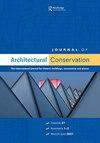Innovative practice in the manufacture of aseptic surgical environments in the late nineteenth century
IF 0.5
3区 艺术学
0 ARCHITECTURE
引用次数: 1
Abstract
ABSTRACT Contemporary spaces for surgery are highly energy intensive, much of which is attributed to powerful air conditioning systems intended to force air down onto the patient, surgical staff and instruments to keep airborne pathogens from sedimenting on patients and equipment during surgery. The carbon footprint from these systems is prodigious in a service required to dramatically cut emissions. Sufficient doubts have arisen from experimental modelling and data collected in surgical theatres that pathogens are expelled efficiently to encourage broader speculation about the fundamental configuration of spaces for surgery. One prospective avenue is the investigation of the aseptic movement’s operating room designs of the late nineteenth and early twentieth centuries before the adoption of air conditioning. Historical review and testing of theatre design, as part of the Excising Infections in Surgical Environments (ExISE) project, identified a carefully designed and innovative operating room in Hamburg’s general hospital. The St. Georg’s Operationshaus (1899) is reconstructed digitally, analysed theoretically and modelled experimentally to determine modern utility as a green theatre. Results are promising but are affected by the parallel intent to introduce prodigious natural daylighting; however, the effects of this on the airflow patterns in the space could be managed by modern materials and control technologies.19世纪末无菌手术环境制造的创新实践
当代手术空间是高度能源密集型的,其中很大一部分归功于强大的空调系统,该系统旨在将空气压向患者,手术人员和仪器,以防止空气中的病原体在手术过程中沉积在患者和设备上。这些系统的碳足迹在需要大幅减排的服务中是惊人的。从实验模型和在手术室收集的数据中产生了足够的怀疑,病原体被有效地驱逐,从而鼓励对手术空间的基本配置进行更广泛的猜测。一个有前景的途径是调查19世纪末和20世纪初在采用空调之前无菌运动的手术室设计。作为手术环境中消除感染(ExISE)项目的一部分,对手术室设计的历史回顾和测试确定了汉堡综合医院精心设计和创新的手术室。St. Georg’s Operationshaus(1899)被数字化重建,理论分析和实验建模,以确定作为绿色剧院的现代效用。结果是有希望的,但受到引入巨大自然采光的平行意图的影响;然而,这对空间气流模式的影响可以通过现代材料和控制技术来控制。
本文章由计算机程序翻译,如有差异,请以英文原文为准。
求助全文
约1分钟内获得全文
求助全文

 求助内容:
求助内容: 应助结果提醒方式:
应助结果提醒方式:


